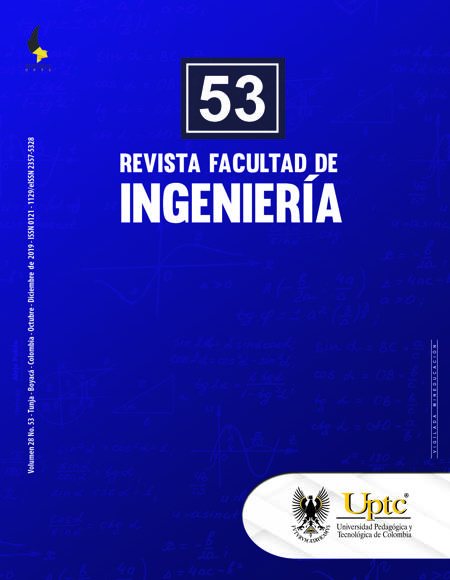Statistical Modeling and Optimization of the Cyanidation Process of Gold Mineral

Abstract
In this paper, we have sought to identify the conditions and optimal operating variables for the processing of a gold ore, in such a way to achieve high efficiency in the recovery of the precious metal. Initially a characterization of the mineral under study was carried out with the performance of different laboratory tests. Likewise, a grinding test was made. In the same way, a sample of ore was classified using a series of Tyler sieves. Next, the material was subjected to gravimetric concentration on a Wilfley concentrator table. The fines, product of the concentration, with a 100 % granulometry through 170 Tyler meshes, were subjected to conventional flotation tests. In this way, to optimize the recovery of gold from the gold ore under study, an experimental design of 2k factorial analysis with central point, three variables and the response surface method was applied to determine the optimal parameters to achieve an efficient recovery during cyanidation. The results obtained show that the mineral has a high degree of cyanide leachability, obtaining a gold recovery of 89.35 %. The research demonstrated that the statistical experimental design is a valuable tool for the efficient processing of the minerals, since it allows finding the optimal parameters of the cyanidation process such as the leaching time, the granulometry of the mineral and the concentration of NaCN. The results obtained with the application of the statistical design in the cyanidation tests allowed determining the optimal operating conditions for a maximum gold recovery.
Keywords
cyanides, floatation, gold, minerals, precious metals, statistical analysis
References
- J. Santamaría, R. Torres, M. Parra, and C. Ortiz. “Comparación de cianuro y tiourea como agentes lixiviantes de un mineral aurífero colombiano,” Revista Facultad de Ingeniería, vol. 22 (34), pp. 97-103, Jun. 2013. https://doi.org/10.19053/01211129.2222. DOI: https://doi.org/10.19053/01211129.2222
- N. Iglesias, F. Carranza, and I. Palencia, “La biolixiviación como pretratamiento de menas auríferas refractarias en matriz de sulfuros,” Revista de Metalurgia, vol. 34 (1), pp. 29-38, Feb. 1998. https://doi.org/10.3989/revmetalm.1998.v34.i1.656. DOI: https://doi.org/10.3989/revmetalm.1998.v34.i1.656
- J. Yánez, I. García, J. Pedraza, and D. Laverde “Caracterización de los minerales auríferos de la zona minera de San Pedro Frío (Bolívar-Colombia), para la selección de los procesos de extracción,” Dyna, vol. 72 (145), pp. 22-35, 2005.
- B. Xu, Y. Yang, T. Jiang, Q. Li, X. Zhang, and D. Wang, “Improved thiosulfate leaching of a refractory gold concentrate calcine with additives,” Hydrometallurgy, vol. 152, pp. 214-222, Feb. 2015. https://doi.org/10.1016/j.hydromet.2014.12.016. DOI: https://doi.org/10.1016/j.hydromet.2014.12.016
- Y. Guo, X. Guo, H. Wu, S. Li, G. Wang, X. Liu, G. Qiu, and D. Wang, “A novel bio-oxidation and two-step thiourea leaching method applied to a refractory gold concentrate,” Hydrometallurgy, vol. 171, pp. 213-221, Aug. 2017. https://doi.org/10.1016/j.hydromet.2017.05.023. DOI: https://doi.org/10.1016/j.hydromet.2017.05.023
- M. Muravyov, and A. Bulaev, “Two-step oxidation of a refractory gold-bearing sulfidic concentrate and the effect of organic nutrients on its biooxidation,” Minerals Engineering, vol. 45, pp. 108-114, May. 2013. https://doi.org/10.1016/j.mineng.2013.02.007. DOI: https://doi.org/10.1016/j.mineng.2013.02.007
- I. Alp, O. Celep, D. Paktung, and Y. Thibault, “Influence of potassium hydroxide pretreatment on the extraction of gold and silver from a refractory ore,” Hydrometallurgy, vol. 146, pp. 64-71, May. 2014. https://doi.org/10.1016/j.hydromet.2014.03.007. DOI: https://doi.org/10.1016/j.hydromet.2014.03.007
- E. A. Oraby, and J. J. Eksteen, “Gold leaching in cyanide-starved copper solutions in the presence of glycine,” Hydrometallurgy, vol. 156, pp. 81-88, Jul. 2015. https://doi.org/10.1016/j.hydromet.2015.05.012. DOI: https://doi.org/10.1016/j.hydromet.2015.05.012
- J. Tremolada, Caracterización, influencia y tratamiento de arcillas en procesos de cianuración en pilas, Master Thesis, Universidad de Oviedo, España, 2011, pp. 19-23.
- E. Salinas, I. Rivera, F. Carrillo, F. Patiño, J. Hernández, and L. Hernández, “Mejora del proceso de cianuración de oro y plata, mediante la preoxidación de minerales sulfurosos con ozono,” Journal of the Mexican Chemical Society, vol. 48 (4), pp. 315-320.
- M. Tanco, and L. Ilzarbe, “Aplicación del Diseño de Experimentos (DOE) para la mejora de procesos,” Memorias, vol. 6, pp. 85-94, 2008.
- J. Chavarriaga, and J. Giraldo. Estudio estadístico de la lixiviación con cianuro como proceso alternativo a la amalgamación y valoración del ambiente laboral de una muestra de entables y compras de oro del municipio de Remedios Antioquia, Grade Thesis, Universidad de Antioquia, Colombia, 2014, pp. 33-49.
- M. Figueredo, “Lixiviación por cianuración de minerales preciosos de un yacimiento en la zona oriental de Cuba,” Infomin, vol. 6 (2), pp. 3-12, 2014.
- P. Navarro, and C. Vargas, “Efecto de las propiedades físicas del carbón activado en la adsorción de oro desde medio cianuro,” Revista de Metalurgia, vol. 46 (3), 227-239, Jun. 2010. https://doi.org/10.3989/revmetalm.0929. DOI: https://doi.org/10.3989/revmetalm.0929
- A. Azañero, V. Aramburú, J. Quiñones, L. Puente, M. Cabrera, V. Falconí, J. Quispe, O. F. Cardoza, K. Jaimes, and A. Medina., “Tratamiento hidrometalúrgico del oro diseminado en pirita y arsenopirita del relave de flotación,” Revista del Instituto de Investigaciones FIGMMG, vol. 13 (25), pp. 7-12, 2010.
- E. Barzola, B. Barzola, D. Lovera, and V. Arias, “Efecto de la moliendabilidad en la cinética de la cianuración de un preconcentrado de Au-Cu,” Revista del Instituto de Investigaciones FIGMMG, vol. 14 (27), pp. 47-52, 2011.
- R. Khosravi, A. Azizi, R. Ghaedrahmati, V. Kumar, and S. Agarwal, “Adsorption of gold from cyanide leaching solution onto activated carbon originating from coconut shell-Optimization, kinetics and equilibrium studies,” Journal of Industrial and Engineering Chemistry, vol. 54, pp. 464-471, Oct. 2017. https://doi.org/10.1016/j.jiec.2017.06.036. DOI: https://doi.org/10.1016/j.jiec.2017.06.036
- I. Korolev, P. Altınkaya, P. Halli, P.-M. Hannula, K. Yliniemi, and M. Lundström, “Electrochemical recovery of minor concentrations of gold from cyanide-free cupric chloride leaching solutions,” Journal of Cleaner Production, vol. 186, pp. 840-850, Jun. 2018. https://doi.org/10.1016/j.jclepro.2018.03.177. DOI: https://doi.org/10.1016/j.jclepro.2018.03.177
- A. Teague, J. S. J. Van Deventer, and C. Swaminathan, “A conceptual model for gold flotation,” Minerals Engineering, vol. 12 (9), pp. 1001-1019, Sep. 1999. https://doi.org/10.1016/s0892-6875(99)00087-4. DOI: https://doi.org/10.1016/S0892-6875(99)00087-4
- J. Zhang, S. Shen, Y. Cheng, H. Lan, X. Hu, and F. Wang, “Dual lixiviant leaching process for extraction and recovery of gold from ores at room temperature,” Hydrometallurgy, vol. 144-145, pp. 114-123, Apr. 2014. https://doi.org/10.1016/j.hydromet.2014.02.001. DOI: https://doi.org/10.1016/j.hydromet.2014.02.001